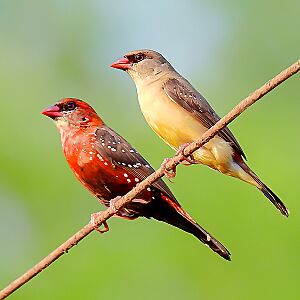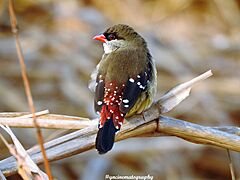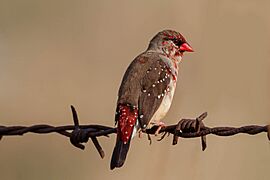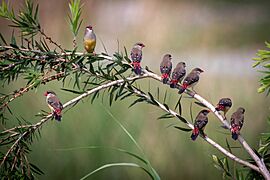Red avadavat facts for kids
Quick facts for kids Red avadavat |
|
|---|---|
 |
|
| Left - male♂, right - female♀
Pair of A. amandava from Maharashtra, India |
|
| Conservation status | |
| Scientific classification | |
| Synonyms | |
|
The red avadavat (Amandava amandava), also known as the red munia or strawberry finch, is a small, colorful bird. It's about the size of a sparrow and belongs to the Estrildidae family. You can find these birds in the open fields and grasslands of tropical Asia. People often keep them as cage birds because the males have very bright feathers during their breeding season. They usually breed in the Indian Subcontinent when the monsoon season arrives. The name avadavat comes from the city of Ahmedabad in Gujarat, India. This is where these birds were once sent from for the pet trade.
Contents
About the Red Avadavat
How Scientists Name Them
Scientists give every living thing a special two-part name. This helps everyone around the world know exactly which species they are talking about. The red avadavat was first officially described in 1758 by a Swedish naturalist named Carl Linnaeus. He gave it the scientific name Frigilla amandava. Later, scientists decided it fit better in a different group, or genus, called Amandava.
Different Types of Red Avadavats
Just like there are different types of dogs, there are also slightly different types of red avadavats. Scientists call these subspecies. There are three main subspecies of the red avadavat:
- A. a. amandava: Found in Pakistan, India, Nepal, and Bangladesh.
- A. a. flavidiventris: Lives in Myanmar, southern China, parts of Thailand, and the Lesser Sundas islands.
- A. a. punicea: Found in southeastern Thailand, Cambodia, southern Vietnam, Java, and Bali.
What They Look Like
This small finch is easy to spot because of its round black tail and a beak that turns red at certain times of the year. The area above their tail, called the rump, is also red.
Male Birds
During the breeding season, the male red avadavat is mostly red on its upper body. It has a black stripe near its eye, a black lower belly, and black wings. You'll also see small white spots on its red body and wing feathers. When it's not breeding season, the male's colors become a bit duller, but its red rump stays bright.
Female Birds
Female red avadavats are generally less colorful than the males. They are duller and have fewer white spots on their feathers.
Where They Live and Their Home
Red avadavats mostly live on flat plains. They prefer places with tall grasses or crops, and they are often found near water.
Natural Homes
The different subspecies are found across various parts of Asia:
- The amandava subspecies lives in Bangladesh, India, Nepal, and Pakistan.
- The flavidiventris form is found in parts of China, Indonesia, Myanmar, and Thailand.
- The punicea subspecies lives further east in Cambodia, Java, and Vietnam.
New Homes Around the World
Because these birds were popular in the pet trade, some have escaped or been released in new places. Now, you can find populations of red avadavats in many other countries. These include southern Spain, Brunei, Fiji, Egypt, Malaysia, the United States, Bahrain, Guadeloupe, Iran, Italy, Réunion, Mexico, the Dominican Republic, Martinique, Portugal, Japan, Puerto Rico, Singapore, and Hawaii.
Their Daily Life and Habits
Social Life and Calls
Red avadavats usually fly in small groups. They have quick wingbeats and often dive into clumps of grass, which makes them hard to see. During the breeding season, a male and female pair will stay together. These birds make a special low, single pseep sound, which they often make while flying. Their song is a series of soft notes. Birds in a flock will even preen each other, ruffling their head feathers to invite grooming.
What They Eat
These finches mainly eat grass seeds. However, they will also eat insects, like termites, when they can find them.
Nests and Eggs
Red avadavats build a round nest using blades of grass. A female usually lays about five or six white eggs.
Beak Color Change
Their beak color changes with the seasons! It starts to turn red around May and gets darker through November and December. Then, in April, the beak quickly turns black. This cycle happens every year and is connected to how long the days are.
Conservation Status
The red avadavat is currently listed as "Least Concern" (LC) for conservation. This means that, overall, their numbers are not critically low. However, in some parts of Southeast Asia, they have become less common. For example, in Thailand, they are now considered uncommon or rare. In Cambodia, many red avadavats were once caught and sent to Vietnam for the pet trade. Even though their numbers are now low and a concern, many were still found in the "merit release" trade in 2012. This trade involves releasing captive birds, often for religious or cultural reasons.
Gallery
-
Red avadavat (male) from Dhaka, Bangladesh










